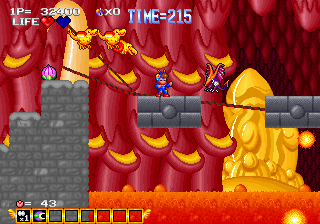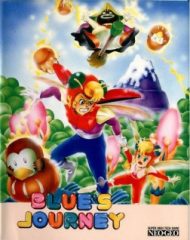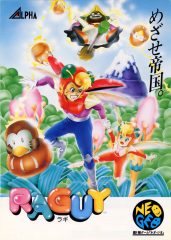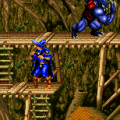Retrospectively, 1991 was a notable year for gaming history. Sega found the mascot they so lustfully sought for with Sonic the Hedgehog, whereas Street Fighter II: The World Warrior irrevocably molded the formerly lackluster genre of 2D fighting games. While these games became era-defining vessels in the unprecedentedly popular sea that was the medium of video games, most other titles would sink and be forced to drift into the depths of obscurity. One such game is Blue’s Journey, one of Neo Geo’s debut titles which was later ported to the Neo Geo CD and Nintendo Wii’s Virtual Console. Developed by the ADK corporation (previously named Alpha Denshi), the eventual producer of such games as Twinkle Star Sprites and the World Heroes series, this game did not culminate into any form of long-term success. Monetary gain and longevity of popularity aside however, Blue’s Journey is still entertaining regardless of whether it’s experienced as a game or as a time capsule.
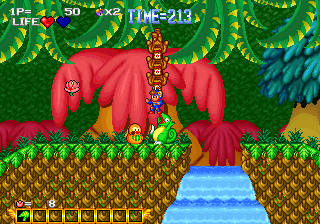
Blue’s Journey (Neo Geo)
Blue’s Journey takes place on the planet of Raguy. Originally teeming with flora, the Daruma tribe invaded Raguy in order to pollute it, in an attempt to bring forth its people’s demise. Blue, seemingly otherwise unfazed by the prospect of an impending mass planetary genocide, was asked by Princess Fa to expunge the threat of the Daruma tribe. Via an impromptu decision fueled by gratuitous masculinity and love, Blue sets out to save his planet. Despite its resemblance to an episode of Captain Planet, the story exists mainly to justify the vivacious artwork.
Blue’s Journey (Neo Geo)
While it’s easy for 2D platformers to seem, at a glance, derivative of one another, Blue’s Journey adequately differentiates itself. It can be played with two players but both function and look identical barring color variations. Blue’s main form of offense, the “leaf dump”, allows him to drop a leaf onto enemies, temporarily stunning them. After picking his foes onto his head during their paralysis, he can launch them, eradicating whichever pest he throws as well the ones in its path of flight. Blue can also jump on an enemy’s head and propel them as he would normally, but if the enemy ricochets and hits him, he will take damage. His attacks can be altered or improved through pickups scattered in each of the game’s boards, swapping his trademark leaf into either a bomb or a boomerang. Blue also has the ability to shrink, although he’s still susceptible to damage from enemies and his offense is nullified while miniature. This mechanic is not pertinent to gameplay and is primarily used to find secrets.
Blue’s Journey (Neo Geo)
Throughout the various levels, Blue encounters shops with scantily clad fairies able to exchange the in-game currency of flowers for items, and other non-playable characters who Blue can barter with, talk to, or at one stage even fight. In order to maximize replayability, there are level branches throughout the game, providing diversity between playthroughs at the option of the player.
Blue’s Journey (Neo Geo)
Presentation is the most powerful facet of Blue’s Journey. The initial board, Jungle Zone 1, is filled with lush vegetation and possesses a tropical aura akin to that of an equatorial forest. Vines hang from the ceiling, while the layered background gives the illusion of an enormous village, displaying the state of Raguy prior to the invasion. The saccharine nature of the first Jungle Zone however allows for effective subsequent juxtaposition. Jungle Zone’s second board has a matching floor, implying a geographical connection, however, the forest which was once so dense that it blocked out the sky is replaced by a dark atmosphere and vehement clouds. As Blue ventures toward the mountain at the board’s end, the few remaining trees are forced to bend backward by the tempestuous gust of the blizzard, a wind so ferocious it even impedes upon him physically during his ascent to the first boss.
Blue’s Journey (Neo Geo)
Aesthetically the art is cartoony, jovial and charming but the truly impressive aspect of the presentation is the utilization of design to propel and add profundity to a story without the use of exposition. The game needn’t tell the players the vast effects of the Daruma Tribe’s pollution, as the art provides compelling evidence. Toward the conclusion, in the aptly titled Mechanical City, whole sections of Raguy have been invaded by the Daruma tribe and in wake of an abundantly green woodland, they’ve constructed a lifeless, computerized metropolis. The increasingly melancholic visual implications of Daruma’s reign, contrasted with the otherwise colorful and cheerful artstyle, adds credence and gravity to Blue’s escapade across Raguy. It should be noted that while the quality of the art is excellent, the sprites are rather small, a rather noticeable departure from other Neo Geo games, which often prided itself on its gigantic characters.
Blue’s Journey (Neo Geo)
Despite the presentation successfully adding magnitude to the story, the music did not follow in suit. Regardless of the morbid implications brought forth through the design of Jungle Zone 2, the same cheerful tune from the first board continues. Not only does the music fail to intensify in a manner analogous to the presentation, its style fails to change at all. By the time the music becomes more thematically appropriate, it fails to become anything more than a mere background tune until the game’s finale. The music prior to this is not atrocious, it merely comes off as uninspired when contrasted against the meticulous presentation of the visuals.
Blue’s Journey (Neo Geo)
In spite of the game’s musical shortcomings and the superficiality of some of the mechanics, there’s still enough quality to suggest this game to people seeking a Neo Geo classic. What Blue’s Journey lacks in technical prowess or ingenuity, it makes up for in personality. From the initial nonchalant stroll through the Jungle Zone, to the sterile, metallic uniformity of the Mechanical City, it presents a likeable odyssey which is well worth the half hour it will take to save Raguy.

